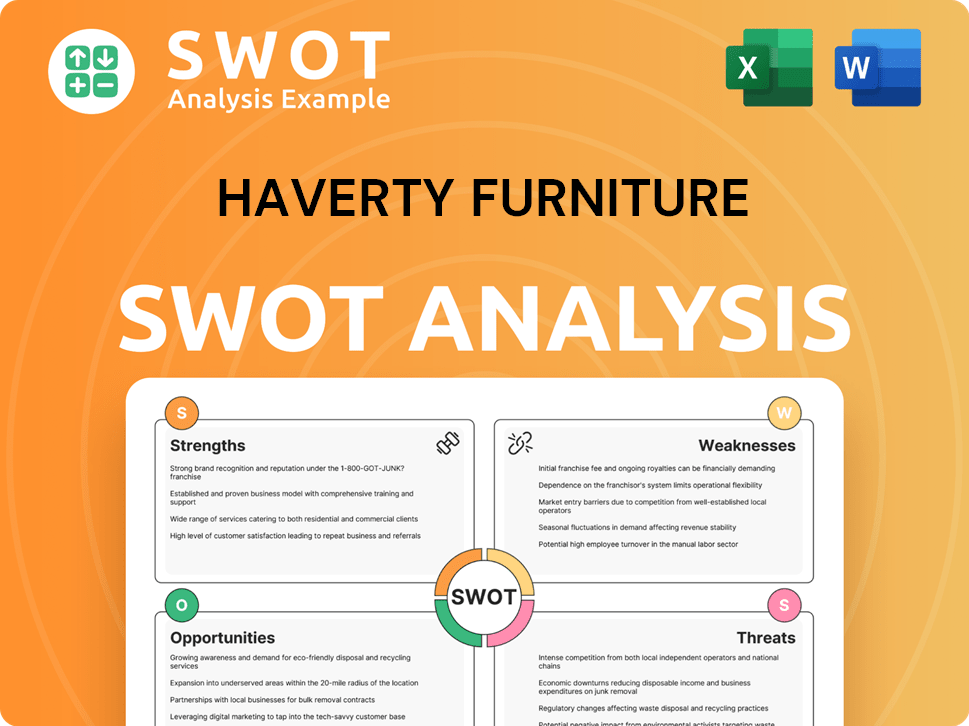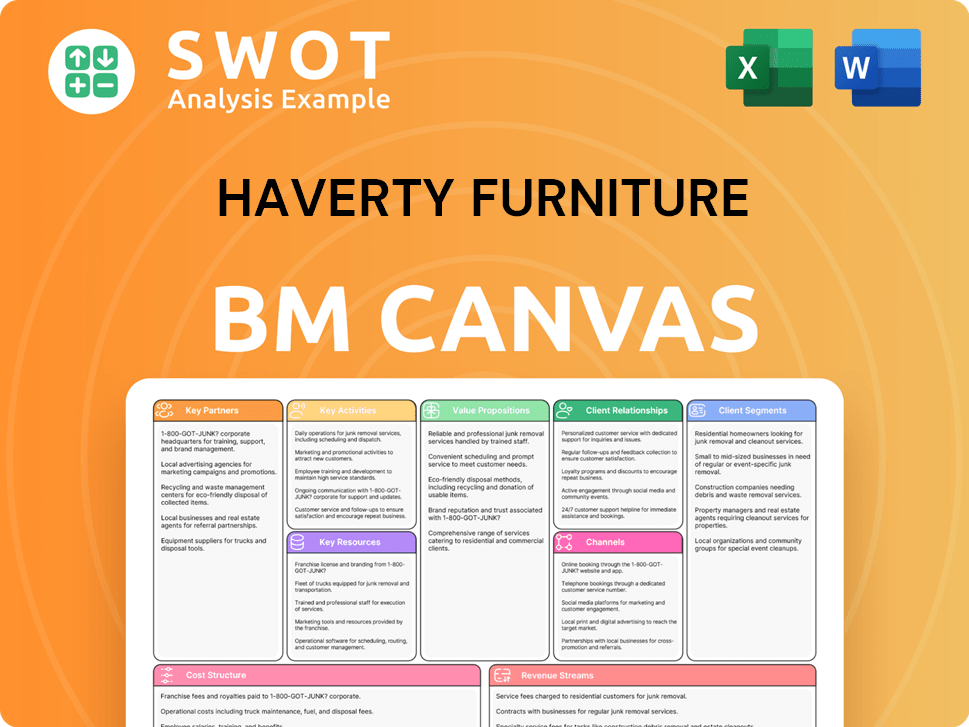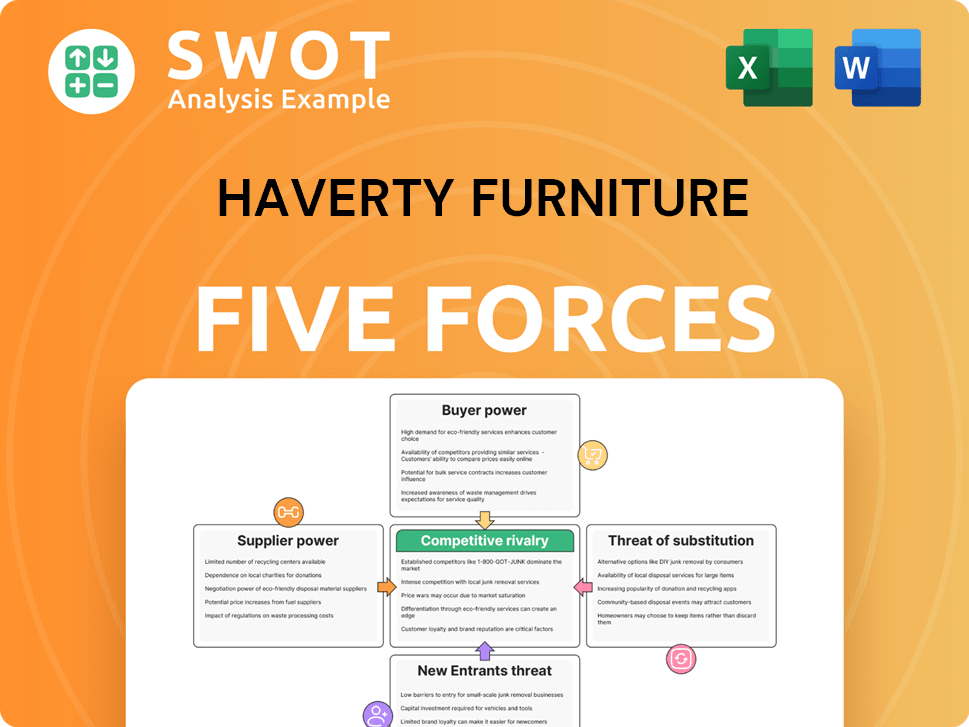Haverty Furniture Bundle
How is Haverty Furniture Redefining Furniture Retail?
In an era where digital transformation reshapes every industry, how does a legacy brand like Haverty Furniture Company stay ahead? From its humble beginnings in 1885, Haverty's has evolved, and its strategic shifts are key to its continued success. Discover how Haverty Furniture Company's sales and marketing strategies are adapting to meet the demands of today's consumers.

This deep dive explores the Haverty Furniture SWOT Analysis, examining its innovative approach to furniture retail marketing. We'll uncover the specifics of Haverty Furniture's sales strategy, including its digital marketing strategy and in-store experience, and analyze its competitive positioning. Furthermore, we'll assess Haverty Furniture's marketing strategy, including its advertising campaigns, promotional strategies, and customer relationship management to understand how it captures its target audience and maintains its market share.
How Does Haverty Furniture Reach Its Customers?
The sales strategy of the company, a leading furniture retailer, centers on a multi-channel approach, blending physical and digital avenues to reach its customers effectively. This strategy is designed to enhance the customer experience and drive sales growth. The core of the company's sales efforts is its network of physical showrooms, complemented by a robust online presence.
The company's primary sales channel is its network of retail showrooms, primarily located in the Southern and Midwestern United States. These showrooms offer a hands-on experience, allowing customers to see and interact with furniture. Alongside the showrooms, the company has significantly invested in its e-commerce platform to meet the growing demand for online shopping.
The company's strategy focuses on maintaining direct control over the brand experience and customer service. This is achieved through its showrooms and website, which allows the company to manage customer interactions and brand messaging directly. The company's e-commerce sales have shown considerable growth, indicating the success of this strategic shift. For instance, in the first quarter of 2024, the company reported an increase in e-commerce sales, underscoring the increasing performance and importance of its online channel relative to its traditional retail stores.
Showrooms provide a tactile experience, allowing customers to view and interact with furniture. The company's showrooms are often complemented by in-store design services to enhance the customer experience. This strategy focuses on maintaining direct control over the brand experience and customer service.
The company has invested in its e-commerce platform to meet the growing consumer demand for online shopping. This digital channel extends the company's geographical reach beyond its physical store locations. The online sales strategy has shown considerable growth, indicating the success of this strategic shift.
The company's omnichannel integration allows customers to seamlessly transition between online browsing, in-store visits, and virtual design consultations. This integration enhances the overall customer journey. The company's approach ensures a consistent brand experience across all touchpoints.
The company primarily operates a direct-to-consumer (DTC) model through its own showrooms and website. This approach allows for direct control over the brand experience and customer service. There are no significant indications of extensive wholesale distribution or franchise models.
The company's sales strategy heavily relies on its physical showrooms and e-commerce platform. The showrooms provide a tangible experience, while the online platform extends the company's reach. This multi-channel approach is designed to cater to diverse customer preferences and enhance the overall shopping experience.
- Showrooms: Physical stores offering a tactile experience.
- E-commerce: Online platform for convenient shopping.
- Direct-to-Consumer: DTC model for direct customer interaction.
- Omnichannel Integration: Seamless transition between online and in-store experiences.
Haverty Furniture SWOT Analysis
- Complete SWOT Breakdown
- Fully Customizable
- Editable in Excel & Word
- Professional Formatting
- Investor-Ready Format

What Marketing Tactics Does Haverty Furniture Use?
The marketing tactics employed by the company are multifaceted, encompassing both digital and traditional methods to build brand awareness and drive sales. The strategy focuses on reaching its target audience through a combination of online and offline channels. The company's approach to marketing is data-driven, with customer segmentation playing a crucial role in tailoring messages and personalizing recommendations.
The company's marketing strategy aims to create a seamless customer experience across all touchpoints, from online browsing to in-store visits. Digital marketing efforts are complemented by traditional advertising, ensuring a broad reach. The company continually evaluates and optimizes its marketing campaigns to maximize effectiveness and return on investment.
The company's marketing strategy is designed to adapt to changing consumer behaviors and market trends. By leveraging both digital and traditional channels, the company seeks to maintain a strong presence in the furniture retail market and connect with its target audience effectively. The company's approach to marketing reflects its commitment to providing a positive customer experience and driving sales growth.
The company utilizes a range of digital marketing tactics. Content marketing, SEO, paid advertising, and email marketing are key components. The company leverages social media platforms, such as Instagram and Facebook, to showcase products and engage with customers.
Content marketing focuses on design trends and style guides. SEO is implemented to improve organic search visibility. This helps potential customers find the company when searching for furniture online.
Paid advertising includes SEM and display ads to target specific demographics. Email marketing is used for lead nurturing, promotions, and customer engagement. These strategies drive traffic and maintain customer relationships.
The company's social media presence features aesthetically pleasing home setups. This encourages user-generated content and promotes aspirational living. Platforms like Instagram and Facebook are key for visual marketing.
Traditional advertising methods, such as TV, radio, and print, are still used. These are particularly effective in regions with physical showrooms. Traditional channels reinforce brand messaging and promote sales events.
Data-driven marketing involves analyzing customer segmentation. This helps tailor marketing messages and personalize recommendations. The company uses data to understand customer preferences and improve targeting.
The company's marketing strategy is designed to reach a broad audience and drive sales. The company focuses on both digital and traditional channels to maximize its impact. The company continually adapts its strategies to stay competitive in the furniture retail market. For more insights, explore the Revenue Streams & Business Model of Haverty Furniture.
- Digital Marketing: Content marketing, SEO, paid advertising, and email marketing are crucial.
- Traditional Advertising: TV, radio, and print ads are used to reach a wider audience.
- Data Analysis: Customer segmentation is used to personalize marketing messages.
- Social Media: Platforms like Instagram and Facebook are used for visual marketing.
Haverty Furniture PESTLE Analysis
- Covers All 6 PESTLE Categories
- No Research Needed – Save Hours of Work
- Built by Experts, Trusted by Consultants
- Instant Download, Ready to Use
- 100% Editable, Fully Customizable

How Is Haverty Furniture Positioned in the Market?
The brand positioning of the company centers on being a specialty retailer of quality residential furniture and accessories. This strategy emphasizes style, selection, and personalized design services, setting the company apart in the competitive furniture retail market. The core message is about helping customers create their ideal home spaces, going beyond just selling furniture; it's about enhancing lifestyles.
The visual identity across showrooms and digital platforms reflects a blend of classic elegance and contemporary design. This approach appeals to a broad, yet discerning customer base, ensuring brand consistency. The tone of voice in marketing materials is inviting, helpful, and aspirational, focusing on comfort, aesthetics, and the joy of home. This helps establish a strong customer relationship management.
The company's unique selling proposition combines product quality with comprehensive design assistance, differentiating it from mass-market retailers. While not positioned as a luxury brand, it emphasizes the lasting value and craftsmanship of its products. This approach is crucial for its overall Haverty Furniture sales strategy. For more insights, you can read about the Brief History of Haverty Furniture.
The primary target audience includes homeowners seeking quality furniture and design services. The company focuses on customers who value style, comfort, and a personalized shopping experience. This includes those who are willing to invest in long-lasting furniture pieces.
The value proposition is centered on providing high-quality furniture with personalized design assistance. This includes a wide selection of styles, expert advice, and a focus on creating a comfortable and stylish home environment. The company aims to offer a seamless and supportive purchasing journey.
The brand messaging emphasizes creating ideal home spaces through quality furniture and personalized design services. The tone is inviting, helpful, and aspirational, focusing on comfort, aesthetics, and the joy of home. This approach aims to resonate with customers seeking both style and functionality.
The company differentiates itself through its focus on quality, design assistance, and customer service. Unlike mass-market retailers, it offers a more curated and supportive purchasing experience. This emphasis on lasting value and craftsmanship sets it apart in the furniture retail market.
The in-store experience is designed to be welcoming and informative, with knowledgeable staff providing personalized design assistance. The website and digital platforms offer a seamless shopping experience, with detailed product information and inspirational content. The goal is to ensure brand consistency across all touchpoints.
The company emphasizes the lasting value and craftsmanship of its products. This commitment to quality is a key aspect of its brand promise. This focus on quality helps to build customer trust and loyalty, which is crucial for long-term success.
Marketing channels include a mix of traditional and digital strategies. This includes in-store promotions, print advertising, and online marketing efforts. The company also utilizes social media marketing to engage with customers and promote its products.
The pricing strategy focuses on offering competitive prices for high-quality furniture. The company often runs promotional strategies to attract customers. The goal is to balance value with profitability, ensuring customer satisfaction and business sustainability.
The company uses digital marketing to enhance its online presence and reach a wider audience. This includes search engine optimization, social media marketing, and targeted advertising campaigns. The online sales strategy is designed to complement the in-store experience.
The company maintains brand consistency across its physical showrooms, website, and marketing communications. This ensures a cohesive customer experience. This consistency helps build brand recognition and trust among customers.
Haverty Furniture Business Model Canvas
- Complete 9-Block Business Model Canvas
- Effortlessly Communicate Your Business Strategy
- Investor-Ready BMC Format
- 100% Editable and Customizable
- Clear and Structured Layout

What Are Haverty Furniture’s Most Notable Campaigns?
The sales and marketing strategy of the company centers around seasonal promotions and holiday events, which are key drivers in the furniture industry. These campaigns are designed to showcase the comfort and style of their furniture, aiming to inspire customers to refresh their living spaces. The company utilizes a blend of digital and traditional advertising to reach its target audience effectively.
The main goals of these campaigns include boosting showroom traffic and online sales, increasing brand awareness, and promoting specific product categories and financing options. Success is measured by sales increases during promotional periods, website traffic, and customer engagement. For instance, promotional strategies influenced a net sales increase during the first quarter of 2024. The company often presents styled room vignettes, demonstrating how its furniture can enhance a home's aesthetic appeal, as part of its Owners & Shareholders of Haverty Furniture marketing efforts.
The strategies are refined by optimizing promotional timing, tailoring messaging for different customer segments, and integrating omnichannel experiences to ensure a seamless customer journey. The company's focus on these elements supports its overall Haverty Furniture sales strategy and helps it maintain a strong presence in the competitive furniture retail market. This approach allows the company to adapt quickly to market changes and customer preferences, ensuring its continued relevance and success.
The Haverty Furniture marketing strategy heavily relies on digital advertising. This includes paid search campaigns, social media ads, and email marketing. These channels are used to reach a broad audience and drive traffic to both online and physical stores.
Traditional media, such as local TV and radio spots, along with print ads in home decor magazines, are also integral to the marketing mix. These methods help reinforce brand awareness and reach customers who may not be as active online. This is part of their overall Haverty Furniture strategy.
Promotional campaigns are typically centered around seasonal sales events and holidays. These campaigns are designed to drive showroom traffic and online sales. They often feature creative concepts highlighting the style and comfort of the furniture.
Customer engagement metrics are used to measure the success of marketing efforts. Website traffic, sales lift during promotional periods, and customer interactions are key indicators. This data informs future marketing decisions and strategy refinements.
The effectiveness of campaigns is measured through various metrics. These include sales lift, website traffic, and customer engagement. For the first quarter of 2024, the company reported a net sales increase, indicating the impact of promotional strategies. These insights help refine the Haverty Furniture sales strategy.
- Sales Lift: Measured by the percentage increase in sales during promotional periods.
- Website Traffic: Analyzed to determine the effectiveness of online advertising and promotions.
- Customer Engagement: Tracked through social media interactions, email open rates, and in-store visits.
- Conversion Rates: Monitor the percentage of website visitors who make a purchase.
Haverty Furniture Porter's Five Forces Analysis
- Covers All 5 Competitive Forces in Detail
- Structured for Consultants, Students, and Founders
- 100% Editable in Microsoft Word & Excel
- Instant Digital Download – Use Immediately
- Compatible with Mac & PC – Fully Unlocked

Related Blogs
- What are Mission Vision & Core Values of Haverty Furniture Company?
- What is Competitive Landscape of Haverty Furniture Company?
- What is Growth Strategy and Future Prospects of Haverty Furniture Company?
- How Does Haverty Furniture Company Work?
- What is Brief History of Haverty Furniture Company?
- Who Owns Haverty Furniture Company?
- What is Customer Demographics and Target Market of Haverty Furniture Company?
Disclaimer
All information, articles, and product details provided on this website are for general informational and educational purposes only. We do not claim any ownership over, nor do we intend to infringe upon, any trademarks, copyrights, logos, brand names, or other intellectual property mentioned or depicted on this site. Such intellectual property remains the property of its respective owners, and any references here are made solely for identification or informational purposes, without implying any affiliation, endorsement, or partnership.
We make no representations or warranties, express or implied, regarding the accuracy, completeness, or suitability of any content or products presented. Nothing on this website should be construed as legal, tax, investment, financial, medical, or other professional advice. In addition, no part of this site—including articles or product references—constitutes a solicitation, recommendation, endorsement, advertisement, or offer to buy or sell any securities, franchises, or other financial instruments, particularly in jurisdictions where such activity would be unlawful.
All content is of a general nature and may not address the specific circumstances of any individual or entity. It is not a substitute for professional advice or services. Any actions you take based on the information provided here are strictly at your own risk. You accept full responsibility for any decisions or outcomes arising from your use of this website and agree to release us from any liability in connection with your use of, or reliance upon, the content or products found herein.